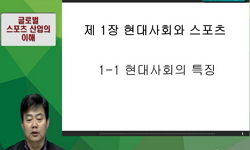- CONTENTS
- Foreword = xiii
- Preface = xiv
- Acknowledgements = xvi
- Abbreviations = xviii
http://chineseinput.net/에서 pinyin(병음)방식으로 중국어를 변환할 수 있습니다.
변환된 중국어를 복사하여 사용하시면 됩니다.
- 中文 을 입력하시려면 zhongwen을 입력하시고 space를누르시면됩니다.
- 北京 을 입력하시려면 beijing을 입력하시고 space를 누르시면 됩니다.
https://www.riss.kr/link?id=M15021086
- 저자
-
발행사항
London ; New York, NY: Routledge, 2018
-
발행연도
2018
-
작성언어
영어
- 주제어
-
DDC
796.01/9 판사항(23)
-
ISBN
9780415789448 (hbk)
9780415789455 (pbk)
-
자료형태
일반단행본
-
발행국(도시)
England
-
서명/저자사항
Sport cyberpsychology / Olivia A. Hurley.
-
형태사항
xvii, 206 p.; 24 cm
-
일반주기명
Includes bibliographical references and index.
What is sport cyberpsychology? -- Types of technology commonly used in sport : an introduction -- Athletic performance : the impact of technology on the mental preparation of elite athletes -- Athletic performance : the role of virtual reality -- The role of technology in athlete-sport psychology consulting -- Athletes and the Internet -- Athletes and social media -- Teams', coaches', and organisations' uses of the online world -- Cyberbullying and cyber-harassment within sporting environments -- Athletes' mental health and problematic online behaviours. - 소장기관
-
0
상세조회 -
0
다운로드
부가정보
목차 (Table of Contents)
- CONTENTS
- Foreword = xiii
- Preface = xiv
- Acknowledgements = xvi
- Abbreviations = xviii
- Part Ⅰ Introducing sport cyberpsychology = 1
- 1 What is sport cyberpsychology? = 3
- 1.1 Overview = 4
- 1.2 Learning objectives = 4
- 1.3 Definitions of relevant terms = 4
- 1.4 A short introduction to sport psychology and cyberpsychology = 5
- 1.4.1 Sport cyberpsychology - a working definition = 5
- 1.4.2 What is sport psychology? = 6
- 1.4.3 What is performance psychology? = 7
- 1.5 What is studied within sport psychology? = 7
- 1.5.1 Mental fitness and mental skills training = 8
- 1.5.2 Concentration = 8
- 1.5.3 Coping = 9
- 1.6 Mental strategies used by athletes = 9
- 1.6.1 Goal setting = 10
- 1.6.2 Self-talk management = 11
- 1.6.3 Relaxation techniques = 11
- 1.6.4 Mental imagery = 11
- 1.6.5 Routines = 13
- 1.6.6 Simulation training = 13
- 1.6.7 Resilience training = 14
- 1.7 Measuring mental skills and strategies using technology - an introduction = 15
- 1.8 A brief historical overview of sport psychology = 16
- 1.9 What is cyberpsychology? = 17
- 1.10 A brief historical overview of cyberpsychology = 18
- 1.11 Why is it important to study sport in the context of cyberpsychology? = 18
- 1.12 Key developments evoking the emergence of sport cyberpsychology = 19
- 1.13 Conclusion = 20
- 1.14 Open-ended discussion questions = 21
- 1.15 Practical exercise = 21
- 2 Types of technology commonly used in sport - an introduction = 25
- 2.1 Overview = 25
- 2.2 Learning objectives = 26
- 2.3 Definitions of relevant terms = 26
- 2.4 New performance-enhancement technology - an introduction = 27
- 2.4.1 The AlterG antigravity (AGAG) treadmill = 29
- 2.4.2 Pressure pads = 31
- 2.4.3 Global Positioning System (GPS) = 31
- 2.4.4 Video analysis technology = 34
- 2.4.5 Eye-tracking technology = 35
- 2.4.6 Smart devices = 36
- 2.4.7 Computer games = 36
- 2.4.8 Wearable technologies = 37
- 2.5 Conclusion, including future directions for research = 38
- 2.6 Open-ended discussion questions = 39
- 2.7 Practical exercise = 40
- Part Ⅱ Exploring the use of technology to prepare athletes for their sport = 43
- 3 Athletic performance : the impact of technology on the mental preparation of elite athletes = 45
- 3.1 Overview = 46
- 3.2 Learning objectives = 46
- 3.3 Definitions of relevant terms = 46
- 3.4 Introduction = 47
- 3.5 Research findings on the impact of GPS devices = 48
- 3.6 Research findings on the impact of video analysis technology = 52
- 3.7 Research findings on the impact of eye-tracking technology = 54
- 3.8 Research findings on the impact of brain-training devices = 55
- 3.9 Research findings on the impact of computer games = 56
- 3.10 Conclusion, including future directions for research = 57
- 3.11 Open-ended discussion questions = 58
- 3.12 Practical exercise = 58
- 4 Athletic performance : the role of virtual reality = 63
- 4.1 Overview = 63
- 4.2 Learning objectives = 64
- 4.3 Definitions of relevant terms = 64
- 4.4 Introduction = 65
- 4.5 Virtual reality as a preparation tool for athletes = 67
- 4.5.1 Virtual reality and mental skills training = 68
- 4.5.2 Virtual reality and anxiety management = 70
- 4.5.3 Virtual reality and injury protection = 70
- 4.5.4 Virtual reality and pain management = 71
- 4.5.5 Virtual reality benefits post-injury = 72
- 4.6 Limitations of virtual reality in elite sport settings = 73
- 4.7 Virtual reality as a preparation tool for other elite performers = 74
- 4.7.1 Dancers = 74
- 4.7.2 Military personnel = 74
- 4.7.3 Medical personnel = 75
- 4.8 Virtual reality as an exercise aid for non-elite populations = 76
- 4.9 Conclusion, including future research directions for virtual reality within sport = 77
- 4.10 Open-ended discussion questions = 78
- 4.11 Practical exercise = 79
- 5 The role of technology in athlete-sport psychology consulting = 83
- 5.1 Overview = 83
- 5.2 Learning objectives = 84
- 5.3 Definitions of relevant terms = 85
- 5.4 Introduction = 86
- 5.5 Professional and ethical considerations within sport psychology = 88
- 5.5.1 Boundary considerations = 91
- 5.5.2 Security and privacy issues = 92
- 5.6 Most popular forms of communication used in consultancy practices = 93
- 5.6.1 Skype and FaceTime = 93
- 5.6.2 Text = 94
- 5.6.3 Blogs = 95
- 5.6.4 Podcasts = 95
- 5.6.5 Webinars = 96
- 5.7 Work-life balance considerations for sport psychologists using technology when consulting = 96
- 5.8 Conclusion and suggestions for future research = 98
- 5.9 Open-ended discussion questions = 98
- 5.10 Practical exercise = 98
- Part Ⅲ Sport personnel in the online world = 103
- 6 Athletes and the Internet = 105
- 6.1 Overview = 106
- 6.2 Learning objectives = 106
- 6.3 Definitions of relevant terms = 106
- 6.4 Introduction = 107
- 6.5 How and why are athletes using the Internet? = 107
- 6.5.1 Meeting needs and goals = 108
- 6.5.2 Information sharing and communicating = 112
- 6.5.3 Promotion options and athletes' brand exposure = 112
- 6.5.4 Educational opportunities = 113
- 6.5.5 Information seeking (anti-doping information) = 116
- 6.5.6 Retirement information and support networks = 117
- 6.6 Athletes' negative Internet use = 118
- 6.6.1 Attention and distraction = 119
- 6.6.2 Misinformation = 120
- 6.6.3 Information overload = 120
- 6.7 Conclusion, including future directions for research = 120
- 6.8 Open-ended discussion questions = 121
- 6.9 Practical exercise = 121
- 7 Athletes and social media = 125
- 7.1 Overview = 126
- 7.2 Learning objectives = 126
- 7.3 Definitions of relevant terms = 126
- 7.4 Introduction = 127
- 7.5 Uses of social media by athletes = 128
- 7.5.1 Personal social networking = 129
- 7.5.2 Professional networking = 130
- 7.5.3 Brand management = 132
- 7.5.4 Fan communication = 132
- 7.6 Self-presentation by athletes using social media = 135
- 7.7 Privacy-related issues for athletes' social media use = 136
- 7.8 The decision-making process for sharing information on social media = 139
- 7.9 Athletes removing online profiles = 139
- 7.10 Conclusion, including future research suggestions = 140
- 7.11 Open-ended discussion questions = 140
- 7.12 Practical exercise = 140
- 8 Use of the online world by teams, coaches and organisations = 144
- 8.1 Overview = 144
- 8.2 Learning objectives = 145
- 8.3 Definitions of relevant terms = 145
- 8.4 Introduction = 146
- 8.5 Use of social media by sport organisations and teams the best and the how = 146
- 8.5.1 Why do sport organisations use online social media platforms? = 147
- 8.6 Use of the online world for player recruitment = 152
- 8.7 Coaches' uses of online platforms = 152
- 8.8 Conclusion, including future directions for research = 153
- 8.9 Open-ended discussion questions = 153
- 8.10 Practical exercise = 154
- Part Ⅳ The dark side of sport cyberpsychology = 157
- 9 Cyberbullying and cyber harassment in sport environments = 159
- 9.1 Overview = 159
- 9.2 Learning objectives = 160
- 9.3 Definitions of relevant terms = 160
- 9.4 Introduction = 161
- 9.5 Examples of cyberbullying of athletes = 164
- 9.6 Cyberbullying of athletes - methods used = 165
- 9.7 Why are athletes popular targets for online bullying and harassment? = 166
- 9.8 Consequences of online bullying and harassment for athletes = 169
- 9.9 Current strategies for combating online bullying and harassment of athletes = 169
- 9.9.1 Education partnerships = 169
- 9.9.2 Team policies = 170
- 9.10 Conclusion, including some directions for future research = 171
- 9.11 Open-ended discussion questions = 172
- 9.12 Practical exercise = 172
- 10 Athletes' mental health and problematic online behaviours = 176
- 10.1 Overview = 176
- 10.2 Learning objectives = 177
- 10.3 Definitions of relevant terms = 177
- 10.4 Introduction = 179
- 10.5 Problematic Internet behaviours displayed by athletes = 180
- 10.5.1 Excessive general Internet use = 181
- 10.5.2 Excessive social networking = 182
- 10.5.3 Problematic online gambling = 183
- 10.5.4 Excessive online gaming = 187
- 10.6 Current strategies employed to help athletes overcome problematic online behaviours = 188
- 10.7 Conclusion, including future directions for research = 189
- 10.8 Open-ended discussion questions = 190
- 10.9 Practical exercise = 190
- Index = 197
온라인 도서 정보
온라인 서점 구매
| 서점명 | 서명 | 판매현황 | 종이책 | 전자책 구매링크 | ||
|---|---|---|---|---|---|---|
| 정가 | 판매가(할인율) | 포인트(포인트몰) | ||||

|
Sport Cyberpsychology (Hardcover) |
판매중 | 300,370원 | 246,300원 (18%) | 12,320포인트 | |

|
Sport Cyberpsychology |
판매중 | 300,370원 | 270,330원 (10%) | 13,520포인트 (5%) | |
- 포인트 적립은 해당 온라인 서점 회원인 경우만 해당됩니다.
- 상기 할인율 및 적립포인트는 온라인 서점에서 제공하는 정보와 일치하지 않을 수 있습니다.
- RISS 서비스에서는 해당 온라인 서점에서 구매한 상품에 대하여 보증하거나 별도의 책임을 지지 않습니다.
책소개
자료제공 : 
Sport Cyberpsychology 양장본 Hardcover
This book uses helpful pedagogical features such as learning objectives, glossaries, case studies, practical exercises, and a companion website to investigate an emerging field that explores how athletes, coaches, sports organisations, and sport science support staff interact with technology and its role in improving performance in sport settings.















